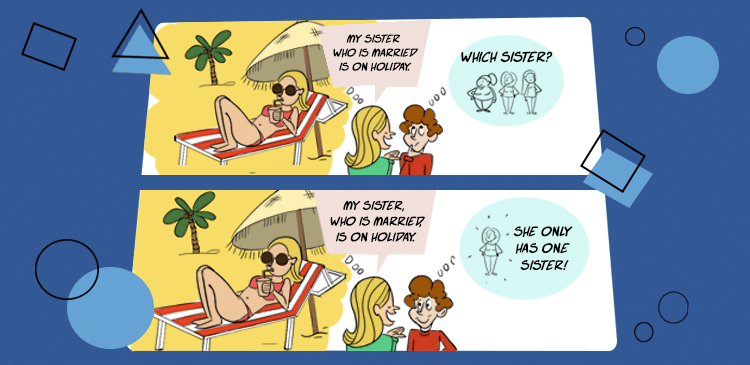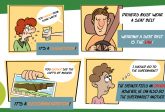Defining and Non-Defining Relative Clauses

Hi folks! As we all know, English grammar is not always a piece of cake! It can sometimes be an uphill struggle. One grammar topic that can often cause confusion is relative clauses. For a recap on the basics of relative clauses please visit our blog post relative clauses.
This post will look at relative clauses in more detail as I will do my best to explain the differences between defining and non-defining relative clauses. All set? Let’s get started then!
Relative clauses
A relative clause is part of a sentence. We use a relative clause to describe nouns. A relative clause gives more information about the person, animal or thing the speaker is referring to.
Learning relative clauses can help English speakers sound more fluent. By using relative clauses speaking and writing become more natural and we avoid repeating the same words in a sentence.
Let’s look at some examples of relative clauses:
The man who is wearing a suit is an accountant.
The student that is sitting down failed the exam.
The cat which has a black tail killed the bird.
Each relative clause in the examples above give us more information about the nouns man, student and cat.
When creating a relative clause, we must begin each relative clause with a relative pronoun. Three common relative pronouns are who, that and which.
In English, there are two types of relative clause: defining and non-defining.
Defining relative clauses
Defining relative clauses define or identify which person, animal or thing we are talking about. The information in a defining relative clause is necessary and important.
For example:
My sister who works in the city centre is married.
This sentence suggests that I have more than one sister. Maybe I have two sisters – one who lives in the city centre and another who lives in the suburbs. The defining relative clause ‘who works in the city centre’ identifies which one of my sisters I am speaking about. Without using a defining relative clause, the listener would not know which sister I am speaking about.
Here’s another example. Imagine you can see three men and you want to tell someone about the men’s jobs. You might say:
The man who is wearing a suit is an accountant.
The man who is sitting down is an electrician.
The man who is on the phone is a teacher.
In this example the defining relative clauses identify each man. If we did not use a relative clause in these sentences, the information would be useless. If you just said “The man is an accountant” the listener would ask “Which man?”. You could now reply “The man who is wearing a suit.”
Notice that defining relative clauses are not separated from the main clause by commas. Furthermore, we can always use that instead of which or who in defining relative clauses.
Omitting the relative pronoun
We can omit the relative pronoun in a defining relative clause if it is the object of the relative clause. Does this sound complicated? Well, to be honest, it is!
Let’s look at an example:
I am writing about the camera that I bought in your shop.
In this sentence the relative clause is ‘that I bought in your shop’.
Who or what is ‘doing’ the action in this clause? the answer is ‘I’. This means ‘I’ is the subject. The relative pronoun ‘that’ is the object. It refers to the camera. To make this clearer we can change the sentence into two sentences:
I am writing about a camera. I bought the camera in your shop.
We can see in the second sentence that ‘I’ is the subject and ‘camera’ is the object. So when we put the sentences together we can omit the relative clause and say:
I am writing about the camera I bought in your shop.
Here are some more examples of sentences where we can omit the relative pronoun:
He called the woman (who/that) he met last week.
The car (which/that) we rented broke down.
The cat (which/that) the children love is called Tabby.
Defining relative clauses
- Define of identify a person, animal or thing
- No commas are used
- We can use that for people, animals or things instead of who or which
- We can omit the relative pronoun when it is the object of the relative clause
Non-defining relative clauses
Non-defining relative clauses do not define the person, thing or animal we are talking about. Non defining relative clauses give extra information about a noun. This information may be interesting or useful, but unlike defining relative clauses, it is not necessary for the meaning of the sentence to be clear.
For example:
Her husband, who comes from Rome, is in hospital.
In this sentence the relative clause ‘who comes from Rome’ does not help us to define the noun. It gives extra information about the noun. The woman only has one husband so we don’t have to answer the question ‘Which husband?’ We call this a non-defining relative clause because it doesn’t define the noun.
When we make a sentence with a non-defining relative clause, we use commas to separate the relative clause from the rest of the sentence. This helps us to determine that the information is not essential in the sentence.
Non-defining relative clauses
- Do not define of identify a person, animal or thing
- Commas are used to separate from the main clause
- We cannot use ‘that’
Comparing a defining clause to a non-defining clause
Let’s compare a defining relative clause to a non-defining relative clause:
Defining: My sister who is married is on holiday.
Non-defining: My sister, who is married, is on holiday.
As you can see, these sentences are identical except for the commas in the second sentence.
The first sentence is a defining relative clause. This sentence does not contain commas. This sentence suggests the speaker has more than one sister and the defining relative clause helps to define which sister the speaker is referring to – the sister who is married.
The second sentence contains commas separating the relative clause from the rest of the sentence. The information contained here is not essential information.
This sentence suggests the speaker only has one sister. The fact that she is married is extra information and does not help to define the noun. This is an example of a non-defining relative clause.
Here are some more examples of non-defining relative clauses:
The president, who was wearing a traditional costume, began the ceremony with a speech.
My sister, who arrived quite late, had some bad news.
The moon, which was full, cast a beautiful light on the village.
As you can see in these examples, the information in a non-defining relative clause is not essential. It is extra information that we don’t need in order to identify the noun.
Test Yourself
Defining and non-defining relative clauses video
Vocabulary
To recap: to repeat the main points of an explanation.
All set?: Means the same as ‘Are you ready?’
Suburbs: An area on the edge of a city where people who work in the city live
Accountant: An expert in keeping or examining financial records
To omit: To not include something
To be honest: Often used in spoken English before we say something that is true but maybe has negative connotations. In text messages we use the abbreviation ‘tbh’
Phrasal Verbs
To break down: To stop working
Example: I need to get a new computer. This one is too slow and sometimes it even breaks down.
Idioms
A piece of cake: Very easy to do
Example: Cooking pasta is a piece of cake.
An uphill struggle: A difficult or challenging task
Example: Making our money last until we next get paid is always an uphill struggle.
Want more? There’s more about relative clauses in Part 1 of this post.
Thank you for reading our post. You’ll find more English grammar tips elsewhere on our site and if you’d like information on our online English courses, please do not hesitate to contact us.





